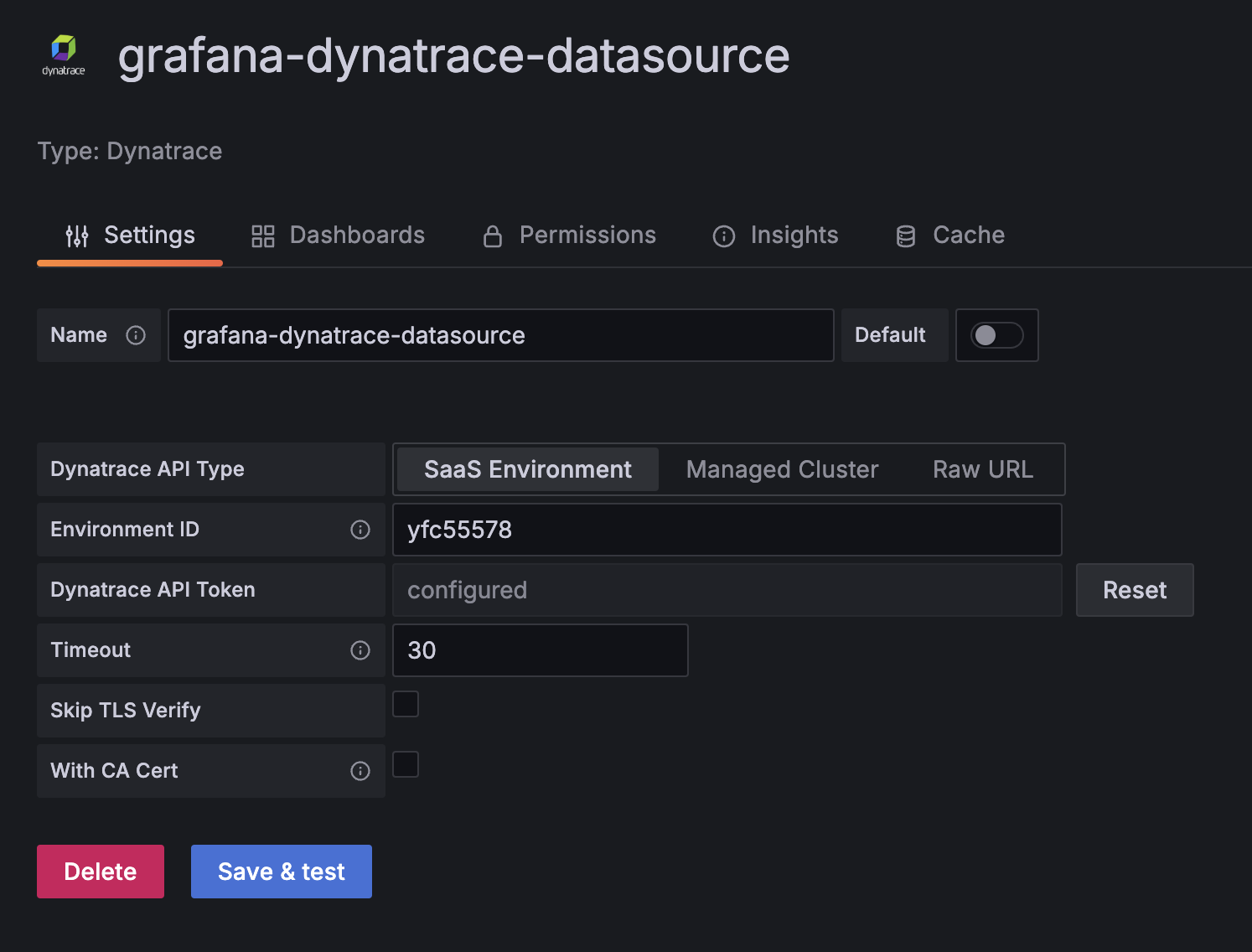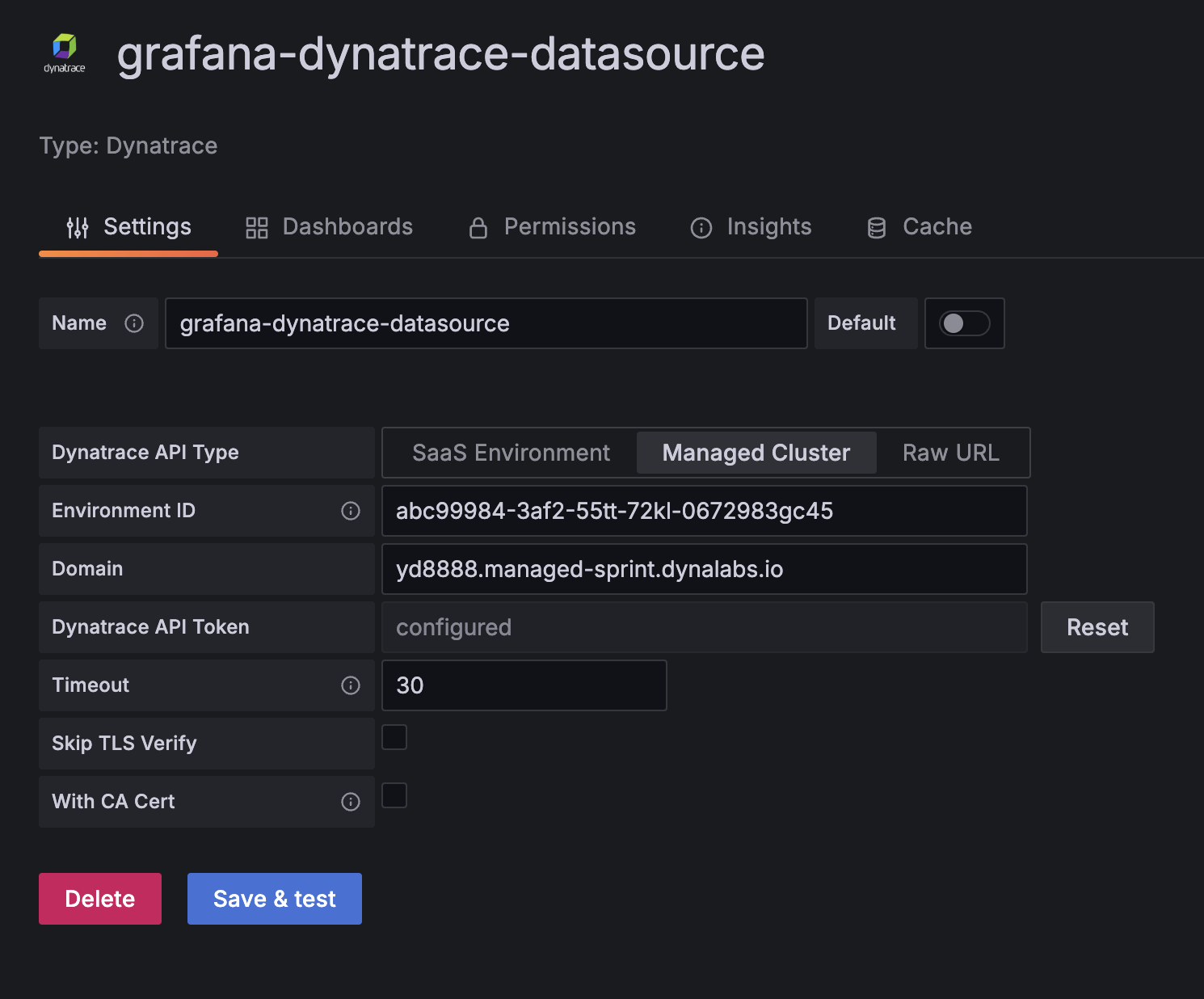Dynatrace data source for Grafana
The Dynatrace data source plugin allows you to query and visualize Dynatrace Metrics, Problems, Audit Logs, Management Zones, Logs and also use USQL from within Grafana. Querying Logs is currently in Beta as the underlying Dynatrace API is an Early Adopter Release.
Requirements
This plugin has the following requirements:
- A Dynatrace account
- One of the following account types:
- Available for users with a Grafana Cloud Free, Advanced or Trial account or with an activated Grafana Enterprise license.
Known limitations
- Template variables cannot be multi-select; only single selection is supported.
- Querying Logs is currently in Beta as the underlying Dynatrace API is an Early Adopter Release.
- Querying Management zones require
Read configurationscope. You can skip this scope, if you don’t want to use management zone filter.
Install the Dynatrace data source plugin
To install the data source, refer to Installation.
Get an API key from Dynatrace
To set up an API token, refer to Dynatrace API - Tokens and authentication.
To query the individual services, you need specific scopes added to your API token.
| Service | Scopes required |
|---|---|
| Metrics | Read metrics, Read entities, (optional : v1: Read configuration ) |
| Problems | v1: Access problem and event feed, metrics, and topology |
| USQL | v1: User sessions |
| Logs | Read logs |
| Audit Logs | Read audit logs |
| Management zones | v1: Read configuration |
| Direct API access | Refer dynatrace API documentation for the scopes required |
Configure the data source in Grafana
Add a data source by filling in the following fields:
- Name
- The name you want to apply to the Dynatrace data source.
- Dynatrace API Type
- The type of Dynatrace instance that you are connecting to. There are 3 options:
- SaaS
- Managed Cluster
- Raw URL
- Environment ID
- In the SaaS example of
yfc55578.live.dynatrace.com, your Environment ID would beyfc55578. In the Managed example ofyd8888.managed-sprint.dynalabs.io/e/abc99984-3af2-55tt-72kl-0672983gc45, your Environment ID would beabc99984-3af2-55tt-72kl-0672983gc45, and your Domain would beyd8888.managed-sprint.dynalabs.io


- Raw URL
- The URL of your custom dynatrace instance. e.g.
https://yfc55578.live.dynatrace.com. Raw URL allows the entry of a URL to a dynatrace instance that falls outside of eitherSaaSorManaged Cluster.

- Dynatrace API token
- An API token generated with
metrics.readandentities.readpermissions. Refer to Get an API key and application key from Dynatrace. - Skip TLS verify
- optional Enable this option if you required to skip TLS verification. Default value: false
- With CA Cert
- optional Needed for verifying self-signed TLS Certs Default value: false. If enabled, you also need to provide the corresponding certificate in CA Cert section
- Timeout
- Defaults to 30 seconds. Configures the http client timeout between Plugin and Dynatrace.
Configure the data source with provisioning
It is possible to configure data sources using config files with Grafana’s provisioning system. To read more about how configuration works, including all the settings that you can set for data sources, refer to Provisioning Grafana.
apiVersion: 1
datasources:
- name: Dynatrace
type: grafana-dynatrace-datasource
jsonData:
apiType: saas
environmentId: environment Id
secureJsonData:
apiToken: API token
- name: Dynatrace Managed
type: grafana-dynatrace-datasource
jsonData:
apiType: managed
environmentId: environment Id # example: abc99984-3af2-55tt-72kl-0672983gc45
domain: domain # example: yd8888.managed-sprint.dynalabs.io
tlsSkipVerify: false
tlsAuthWithCACert: true
httpClientTimeout: 360
secureJsonData:
apiToken: API token
tlsCACert: |
-----BEGIN CERTIFICATE-----
1221323123213123231231232+g6DAzj/11231
sdsaas==
-----END CERTIFICATE-----Query the data source
The query editor allows you to configure 4 different types of dynatrace queries.
Query
The query type can be Metric, Problems, USQL, Logs, Audit Logs, Management Zones or Direct API Access.
Metric query type
- Management Zone (optional)
- Select management zone(s) to filter results by management zone.
- Metric
- Select the metric that you want to see. To get the metric list from Dynatrace again, click the Refresh button.
- Aggregations
- Select the aggregation you want to use for a specific metric. Click the aggregations value to change the aggregation type or click the + button to add another aggregation.
- Transformations
- You can select transformations in the query editor. Afterwards, enter a number of parameters into the selected transformation. Currently, only the merge transformation is supported. For information about the merge transforms, refer to Merge transformation.
- Filters
- The Dynatrace plugin dynamically queries the appropriate filters for each metric.
- To add a filter, click the + symbol next to the
Filterslabel on the Dynatrace query editor, select which field you would like to filter on, select the operator you would like to use, and then select a value to filter by. - The Dynatrace plugin allows you to create
Filter Groupsthat you can join together to create complex logical comparisons. For most use cases,Filter Groupsare not required. - When creating filters with
Tags, regardless of the conjunction selected, Dynatrace will always useAND. Dynatrace does not supportORfilters withTags. - Alias
- There are two different types of aliases you will encounter while using the Dynatrace plugin. The first is a
static alias. An alias of this type is available on every query that you build, and the name of the alias starts with a lowercase letter. The second is adynamic alias, which changes based on the metric that you are using in your query, and the name of the alias starts with an uppercase letter. - The Dynatrace plugin supports several different aliases:
Metric Names,Aggregation,Display Name,Host, andDescription.
| Name | Value |
|---|---|
| $name | builtin:apps.other.keyUserActions.reportedErrorCount.os |
| $aggregation | auto,value |
| $displayName | Reported error count (by key user action, OS) [mobile, custom] |
- Limit
- Set a Limit to the size of the results. Each series will be limited by this amount.
Problems query type
- Problem Query Type
- Select a problem query type. Currently, only the feed problem query type is supported. For information about the feed problem query type, refer to Problems API - GET feed.
- Status Filter
- Filter the result problems by the status.
- Impact Filter
- Filter the result problems by the impact level.
- Severity Filter
- Filter the result problems by the severity level.
- Expand Details
- Include related events to the response, if set.
USQL query type
- USQL Query Type
- Select the USQL Query type. This query type uses the user sessions API
- USQL Query
- The toolbar to the left of this area has 3 options
- Revert: Will revert your query to the latest saved query
- Save: Saves the current query and will execute the query (Alt+S/Cmd+S/Click). The toggle switch to the right is to enable auto-save. In auto-save mode, the query will be saved as soon as you navigate away from the query editor. (ie: Hit the refresh button)
- Add Deeplink Fields: When toggled will return deeplinked fields in the query as an additional dataset. Transformations can then be used to further massage the data.
Logs query type
- Query
- The log search query. The query must use the Dynatrace search query language. Example Query:
log.source="/var/log/syslog" AND (loglevel="error" OR loglevel="warn") - Sort
- This defines how to sort the results.
Results are filtered based on dashboard timerange automatically.
Refer the underlying API documentation here for more details and limitations.
Note: The Logs query type is in beta. Please report any unexpected behavior to the Grafana Support team. The underlying Dynatrace API is an early adopter release. The API may change in ways that are not compatible with this plugin.
Audit Logs query type
- Filter
- Filters the audit log. You can enter the filter query as specified in the DynaTrace API Documentation. Example Query:
eventType("CREATE","UPDATE"),category("CONFIG") - Sort
- This defines how to sort the results.
Results are filtered based on dashboard timerange automatically.
Refer the underlying API documentation here for more details and limitations.
Direct API Access query type
: Direct API Access allows querying any other dynatrace api endpoint, but will require that you parse out the data using JSON Path expression
- API Endpoint
- Enter the portion of the api endpoint starting with the version. Examples:
API Documentation API Endpoint Synthetics v2/synthetic/locationsEvents v2/events - Parse using JSONPath
- This is the default. When selected, the response is returned with column headers as JSON paths, making it simple to parse out individual fields if desired.
- Field
- Enter the JSON Path of the field to extract in the response
- Type
- Select the type the data should be extracted as. If using auto, the type will be automatically detected. For numbers that are within one year of the current UNIX Millisecond Epoch, the field will be of type “time”. Note that times that fail to be parsed as a time will be returned with a value of
nil. - Alias
- Select the Alias. When entered, the column header/name will reflect the alias entered. Currently, template variables are not supported. Leave blank to use the default, which is the JSON path.
- Plus
- At the far right of a field line entry, clicking the plus sign will add an additional field.
Templates and variables
To add a new Dynatrace query variable, refer to Add a query variable. Use your Dynatrace data source as your data source for the following available queries:
- Query type
- Select a query type. The query type associate some data with some key or descriptor.
| Query type | Description |
|---|---|
| Metric names | Returns a list of all metric names |
| Filter keys | Returns a list of all the possible dimensions (e.g. Hostname) that can be used to filter |
| Filter values for key | Returns a list of filtered values by a key name or a key name template variable |
| Problem status options | Returns a list of all problem statuses |
| Problem impact options | Returns a list of all problem impacted areas |
| Problem severity options | Returns a list of all problem severity types |
| Query Editor | Allows you to configure a customer query using the query editor for which you can use |
| to create a custom template variable. The query must return only 1 column. | |
When your query is returning 1 column, hit the Apply button. | |
optionally, a raw query can return two columns named text and value to have different display values for the values |
- Regex
- (Optional) Filter out any of the returned values from your query with a regular expression
Note: Multi-value and Include All option are currently not supported by the Dynatrace plugin.
After creating a variable, you can find it in the Metric drop-down menu. For more information about variables, refer to Templates and variables.
Import a dashboard for Dynatrace
To import a dashboard, refer to Importing a dashboard. Imported dashboards can be found in Configuration > Data Sources > select your Dynatrace data source > select the Dashboards tab to see available pre-made dashboards.
Get the most out of the plugin
- Add Annotations.
- Configure and use Templates and variables.
- Add Transformations.
- Set up alerting; refer to Alerts overview.



